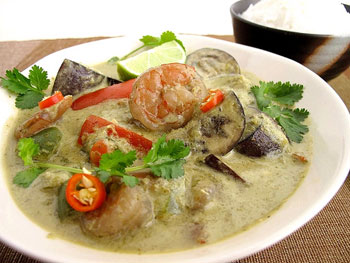 I cannot go to a Thai restaurant without ordering green curry. It is by far my most favorite Thai dish and I've eaten so many versions that I can almost say I'm an expert in its flavor. Something about the creamy coconut sauce with slight sweetness, the hot chiles, the green color, and verdant flavor makes me crave this dish very often. Curry, a generic term for dishes in South Asian cuisine, is known for its use of distinctive spices combined to form unique flavor. Most Westerners assume that curry is a single spice or a mixture of them. Although this is somewhat true, the word curry, an Anglicization of the Tamil word khari, references the nature of the dish: a stew, sauce, or gravy; not the spices. The colonizing English happened to call all saucy South Asian foods by the name curry, and the name stuck.
I cannot go to a Thai restaurant without ordering green curry. It is by far my most favorite Thai dish and I've eaten so many versions that I can almost say I'm an expert in its flavor. Something about the creamy coconut sauce with slight sweetness, the hot chiles, the green color, and verdant flavor makes me crave this dish very often. Curry, a generic term for dishes in South Asian cuisine, is known for its use of distinctive spices combined to form unique flavor. Most Westerners assume that curry is a single spice or a mixture of them. Although this is somewhat true, the word curry, an Anglicization of the Tamil word khari, references the nature of the dish: a stew, sauce, or gravy; not the spices. The colonizing English happened to call all saucy South Asian foods by the name curry, and the name stuck.
The most well-known curries are Indian and Thai, but the combination of ingredients differ greatly. Thai curries use a vast array of fresh herbs and vegetables such as cilantro, kaffir lime leaves, and lemongrass to lend incomparable aroma. The base of the green curry comes from the all-important paste, which combines lemongrass, lime leaves, shallots, garlic, ginger, cilantro, chiles, and the spices coriander and cumin along with the particularly Thai ingredients: fish sauce and shrimp paste. All of the Thai curries begin with a similar flavorful paste, but of course a red curry will begin with a red paste, and a yellow with a yellow. The "green" ingredients create the unforgettable fresh flavor that is the base for green curry.
To make this green curry, a portion of the paste is sautéed briefly and then combined with the creamy coconut milk, which is an essential Southeast Asian flavor component that makes this curry very much Thai. Finally the vegetables, including the traditional Thai eggplants, simmer in the sauce before the shrimp is added to poach for just a few minutes. Many of the unique ingredients in this recipe can be found in the international aisle of most local supermarkets, but scarcer items, such as fresh kaffir lime leaves, can be found in Asian stores or even online. I've suggested some substitutions in the recipe if certain ingredients cannot be acquired. By all means, creative substitutions are fine.
Green Curry Shrimp
2 tablespoons canola oil
1 cup green curry paste, recipe follows
2 14-ounce cans unsweetened coconut milk
1/2 cup seafood stock or water
2 tablespoons nam pla (Thai fish sauce)
1 tablespoon brown sugar
fine sea salt
2 bell peppers, 1 green and 1 red, sliced
6 small Thai or Indian eggplants, quartered
1-1/2 pounds large shrimp, peeled and deveined
1/2 cup Thai basil or sweet basil leaves
2 tablespoons lime juice (from about 1 lime)
sliced red Thai bird chile, for garnish
cilantro leaves, for garnish
cooked Jasmine rice, for serving
Warm oil in a well-seasoned wok or large nonstick sauté pan set over medium-high heat. Add curry paste and sauté for 2 minutes. Pour in coconut milk, nam pla, and stock. Add sugar and season with salt. Bring mixture to a boil. Add eggplants and peppers. Lower to a simmer and cook until vegetables are tender and sauce thickens, about 8 minutes. Add shrimp and cook until pink, about 2 minutes. Stir in basil leaves and lime juice. Garnish with red chile slices and cilantro leaves. Serve alongside Jasmine rice. Yield: 4 servings.
Green Curry Paste
3 stalks lemongrass, outer leaves and grassy tops removed, coarsely chopped
6 fresh kaffir lime leaves or 2 tablespoons lime zest (from about 2 limes)
3 shallots, coarsely chopped
4 garlic cloves, coarsely chopped
12 green Thai bird chiles, coarsely chopped
2-inch piece ginger, peeled and coarsely chopped
1 large bunch cilantro
2 teaspoons coriander seeds, toasted and ground
2 teaspoon cumin seeds, toasted and ground
1 teaspoon freshly ground white pepper
1 teaspoon shrimp paste
1/4 cup nam pla (Thai fish sauce)
1/4 cup lime juice (from about 2 limes)
Combine lemongrass, lime leaves, shallots, garlic, chiles, ginger, cilantro, spices, and shrimp paste in the bowl of a food processor. Pulse until very finely chopped. Stream in nam pla and lime juice. Process until consistency resembles that of paste. Yield: 2 cups.
Joseph Erdos is a New York–based writer and editor, but above all a gastronomer and oenophile. He shares his passion for food on his blog, Gastronomer's Guide , which features unique recipes and restaurant reviews among many other musings on the all-encompassing topic of food.

